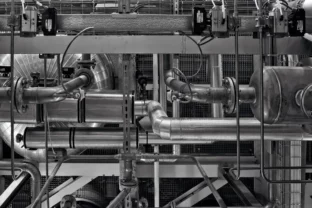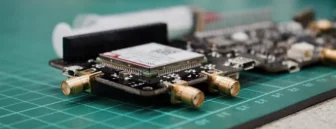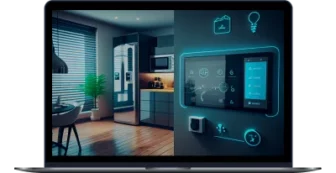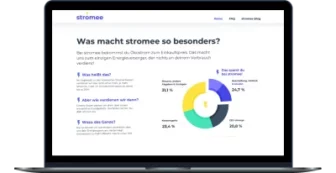
Automotive IoT for Enhanced Sustainability and Citizen Welfare: How to Open New Business Opportunities by Solving Critical Urbanization Problems
Summarize:
As our cities undergo rapid transformation due to urbanization, we’re faced with a slew of challenges that demand innovative solutions. From endless traffic jams to environmental concerns, the issues stemming from urban growth are hard to ignore. However, within these challenges lie opportunities for businesses to thrive owing to the automotive industry.
WANT TO KNOW HOW YOUR BUSINESS MAY BENEFIT FROM AUTOMOTIVE IOT?
Download the listBy highlighting the benefits and improvements in the lives of end users resulting from automotive IoT solutions, businesses can effectively showcase the real value and impact of their offerings, driving adoption and loyalty among customers while also achieving business success and growth.
IoT services play a crucial role in enabling these automotive solutions, providing connectivity, data processing, and real-time analytics that enhance vehicle performance and user experience.
In this article, we’ll explore how automotive IoT not only expands the automotive industry and helps make cities more sustainable and improves the well-being of citizens but also paves the way for businesses to flourish.
In this article, we’ll explore how automotive IoT not only expands the automotive industry and helps make cities more sustainable and improves the well-being of citizens but also paves the way for businesses to flourish.
A quick Q&A session for wider context: What does IoT in automotive embrace?
Q #1: What is automotive IoT?
Automotive IoT, short for Automotive Internet of Things, refers to the integration of Internet of Things (IoT) technology into vehicles and the automotive industry ecosystem. Such integration follows the aim of enabling connectivity and communication between vehicles, infrastructure, and other devices. As a result, IoT in automotive helps to:
- enhance vehicle performance
- contribute to greater safety
- increase the efficiency of commercial vehicles
- improve overall driving experience
Q #2: How does automotive IoT work?
In a nutshell, IoT in automotive exploits various sensors, actuators, and connectivity solutions to collect and exchange data between vehicles and the surrounding environment. This data can include information about:
- Vehicle diagnostics
- Location
- Speed
- Fuel consumption
- Driver behavior
- And more.
By analyzing and processing this data in real-time, IoT in automobiles enables intelligent decision-making and automation in various aspects of automotive operations and services, such as:
- Vehicle diagnostics and maintenance
- Fleet management
- Driver behavior monitoring and analysis
- Connected infotainment systems (i.e. systems that enable voice-activated controls, smartphone integration, central display screen, touchpad controller, navigation with 3D maps and real-time traffic information)
- Usage-based insurance
- Automated emergency assistance

Q #3: What are key components of IoT for automotive that enable connectivity and communication?
Key component of IoT in automotive include:
Connected vehicles. Connected vehicles are equipped with built-in connectivity features such as cellular, Wi-Fi, or Bluetooth capabilities. These connections enable vehicles to communicate with each other, with cloud-based platforms, and with external devices or systems.
IoT sensors. Embedded sensors (for example, in connected cars) gather data on various aspects of vehicle operation, including engine performance, fuel consumption, tire pressure, temperature, and more. These sensors provide real-time insights into vehicle health, driving conditions, and environmental factors.
Telematics systems. Telematics systems provide the infrastructure for collecting, transmitting, and analyzing vehicle data. They consist of onboard computers, communication modules, and cloud-based platforms that enable remote monitoring, diagnostics, and control of vehicles. Additionally, IoT data visualization and notification capabilities can enhance the effectiveness of telematics systems by delivering real-time, actionable insights and alerts based on vehicle performance.
Cloud computing. Cloud-based platforms ensure storage, processing, and analytics capabilities for vast amounts of vehicle data as well as enable advanced functionalities such as predictive maintenance, remote software updates, and personalized services tailored to individual drivers’ preferences.
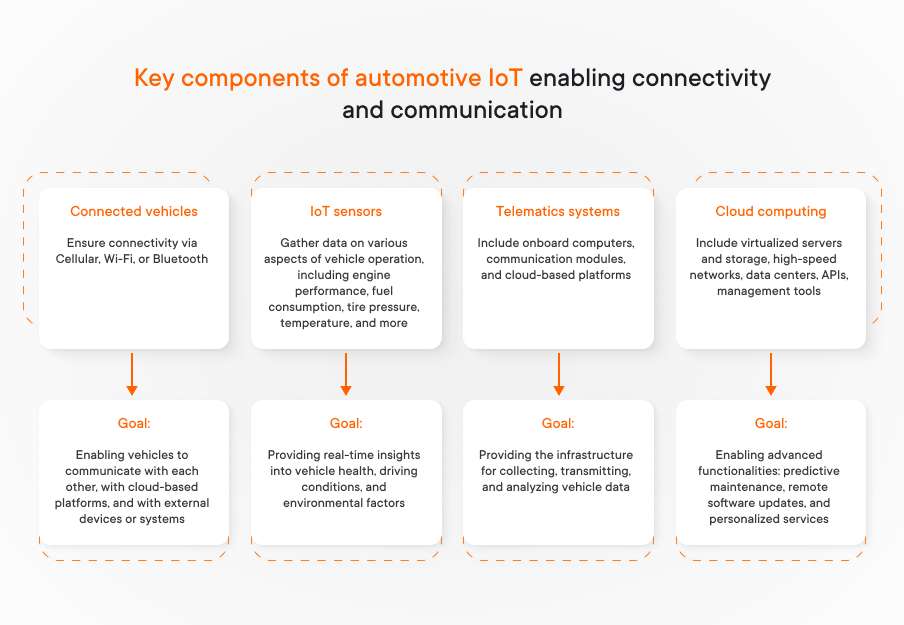
How can IoT in automotive industry solve the most critical urbanization problems?
Urbanization is changing our cities and transforming the way we do business and innovate in technology. With more people moving to urban areas in search of better opportunities, the speed of urban development has skyrocketed. However, despite the bright side of development, urbanization brings significant environmental issues that can impact the quality of life for citizens such as:
- Traffic congestion. Rapid urbanization leads to increased vehicular traffic, congestion, longer commute times, and increased air pollution.
- Air pollution. Concentration of vehicles and industrial activities in urban areas often leads to poor air quality, posing health risks to residents.
- Parking issues. Limited parking spaces coupled with the growing number of vehicles result in challenges related to finding parking spots, traffic congestion, and frustration among drivers.
- Road safety. Higher population density and increased traffic contribute to road accidents, posing risks to pedestrians, cyclists, and motorists alike.
- Inefficient public transportation. Many urban areas struggle with inadequate public transportation infrastructure, overcrowding, unreliable services, and longer commute times.
In turn, the IoT automotive industry enables comprehensive remote management of everything aforementioned with the help of devices that collect and transfer environmental and urban data in real-time. With ML-powered data processing and visualization, local authorities are able to transform over-polluted and overwhelmed territories into smart cities.
Here’s how IoT in automotive contributes to this:
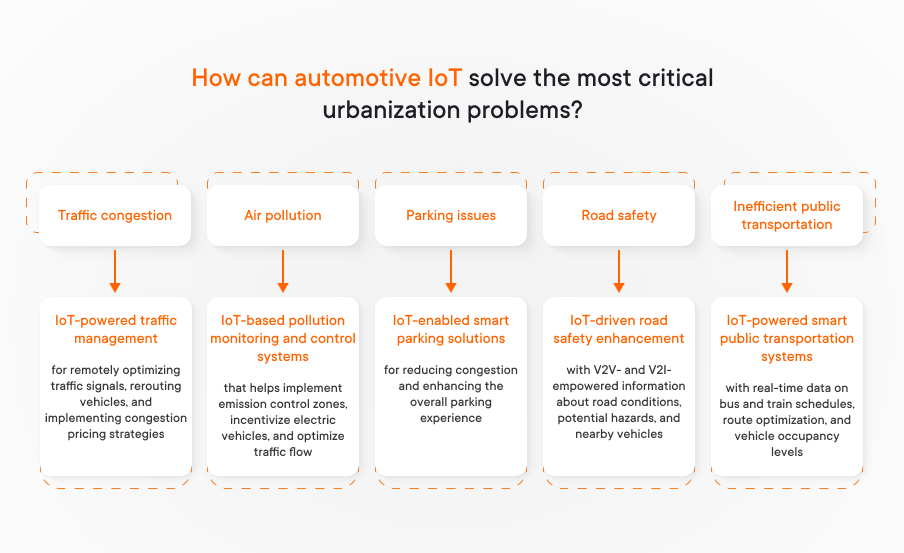
1. Traffic management. IoT automobiles, i.e. connected cars, traffic lights, and roads can collect real-time data on traffic flow, helping authorities to remotely optimize traffic signals, reroute vehicles, and implement congestion pricing strategies to decrease traffic congestion.
2. Pollution monitoring and control. IoT sensors can monitor air quality levels and emissions from vehicles and industrial sources (industrial IoT solution). With this data, authorities can implement such countermeasures as emission control zones, incentivizing electric vehicles, and optimized traffic flow to reduce pollution levels.
3. Smart parking solutions. IoT sensors parking sensors can provide real-time information on parking space availability, guiding drivers to vacant spots and reducing the time spent searching for parking. This helps reduce congestion and enhances the overall parking experience.
4. Road safety enhancement. IoT in automotive industry can enable vehicle-to-vehicle (V2V) and vehicle-to-infrastructure (V2I) communication, allowing vehicles (including autonomous vehicles) to exchange information about road conditions, potential hazards, and nearby vehicles. This facilitates the implementation of advanced driver assistance systems (ADAS) and improves overall road safety.
5. Improved public transportation. IoT-powered smart public transportation systems can provide real-time data on bus and train schedules, route optimization, and vehicle occupancy levels. This improves the efficiency and reliability of public transportation services, encouraging more people to use them and reducing reliance on individual vehicles.
GET AN EXPERT OPINION ON THE ROLE OF IOT IN ENSURING SUSTAINABILITY:
Listen to Taichi Nagakubo, Chief operating officer and product owner at Toyota Tsusho Mobility Informatics, talking about how IoT components serve the sustainability needs:
Technological challenges your business may encounter when dealing with IoT for automotive and ways to overcome them: A guide from Yalantis
Dealing with automotive IoT presents several challenges for businesses, ranging from technical complexities to regulatory compliance. Here are some common challenges and ways to overcome them designed by our experts who manage IoT in automotive projects:
#1: Data security and privacy concerns
Challenge: Collecting, storing, and transmitting sensitive vehicle and driver data raise concerns about data security and privacy breaches.
Solutions:
- Implement robust cybersecurity measures, including:
– Encryption
– Access controls
– Regular security audits - Adhere to data protection regulations such as GDPR or CCPA
- Ensure transparent data handling practices to build trust with customers
Learn more about cybersecurity best practices for web and mobile app development from our experts
Read the recommendations#2: Interoperability issues
Challenge: Integrating IoT devices, software, and platforms from different vendors may lead to compatibility issues and interoperability challenges.
Solutions:
- Prioritize standardization and compatibility when selectingIoT solutions and technologies
- Embrace open-source platforms and industry standards to facilitate seamless integration and interoperability
#3: Complexity of system integration
Challenge: Integrating automotive IoT solutions with existing IT infrastructure, legacy systems, and third-party applications can be complex and time-consuming (IoT app development services) .
Solutions:
- Invest in robust integration tools and middleware to streamline the integration process
- Adopt an agile approach to development and deployment, breaking down integration tasks into manageable phases and conducting thorough testing at each stage
#4: Regulatory compliance
Challenge: Adhering to regulations and standards related to vehicle safety, emissions, data privacy, and cybersecurity poses compliance challenges for automotive IoT businesses.
Solutions:
1. Stay informed about regulatory requirements and proactively monitor changes in relevant laws and standards via:
a. Government websites
b. Industry publications and journals
c. Trade associations and industry groups
d. Webinars and conferences
e. Regulatory databases and repositories
f. Consulting and advisory companies
2. Collaborate with legal experts to ensure compliance with applicable regulations and maintain a proactive approach to regulatory compliance
#5: Reliability and quality assurance
Challenge: Ensuring the reliability, performance, and quality of automotive IoT devices and systems is essential for customer satisfaction and safety.
Solutions:
- Implement rigorous testing and quality assurance processes throughout the product development lifecycle
- Conduct extensive field testing and gather feedback from users to identify and address potential reliability issues proactively
#6: Scalability and resource constraints
Challenge: Scaling automotive IoT solutions to accommodate growing user bases and increasing data volumes may strain resources and infrastructure.
Solutions:
- Design scalable architectures and infrastructure from the outset, leveraging cloud computing and edge computing technologies to handle scalability requirements efficiently
- Prioritize resource optimization and capacity planning to ensure smooth scalability without compromising performance
#7: User acceptance and adoption
Challenge: Convincing consumers and businesses to adopt Internet of Things automotive solutions may face resistance due to concerns about cost, complexity, or perceived risks.
Solutions:
- Educate stakeholders about the benefits of automotive IoT, including improved safety, efficiency, and cost savings
- Provide user-friendly interfaces, clear documentation, and training programs to facilitate adoption and minimize resistance
By addressing these challenges proactively and leveraging best practices and innovative approaches, businesses can overcome obstacles and unlock the full potential of automotive IoT to drive success and innovation in the automotive industry.
FOUND A PROBLEM YOUR BUSINESS STRUGGLES TO SOLVE?
Request a detailed roadmap from our experts and get a thorough analysis of your business strategy
Business opportunities IoT automotive enables – are they worth it?
IoT automotive presents multiple business opportunities for companies ranging from small and mid-sized enterprises to larger corporations. Moreover, businesses can expect collaborations with local municipalities and other governmental establishments. This is because countries put much effort into enabling healthier and more sustainable environments in big cities, paying special attention to IoT in the automotive and:
- Smart city initiatives. Many governments worldwide are investing in smart city projects aimed at leveraging technology to improve urban infrastructure, transportation systems, and public services
- Research and development funding. Governments often allocate funding for research and development (R&D) initiatives in the automotive industry oriented on advancing technology in critical areas.
- Environmental sustainability programs. Governments and environmental agencies offer grants and sponsorships for initiatives that address environmental challenges, such as reducing vehicle emissions, improving air quality, and promoting sustainable transportation solutions.
- Public-private partnerships. Governments collaborate with private sector companies through public-private partnerships (PPPs) to implement large-scale projects, including infrastructure development, transportation upgrades, and smart city initiatives.
And here’s a list of potential opportunities for each type of businesses:
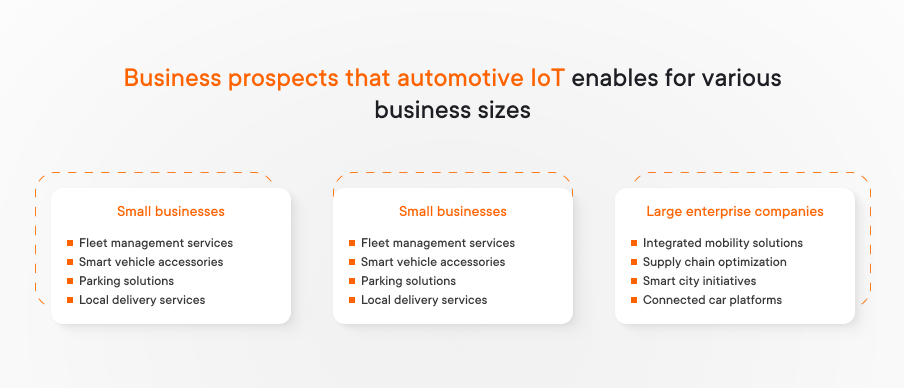
Small businesses
Considering the limited resources and investments small businesses have, they can jump into the automotive sector start with improving:
Fleet management services. Small businesses can jump into automotive IoT to monitor and optimize their fleet operations with connected cars, including vehicle tracking, fuel efficiency monitoring, and maintenance scheduling. This can lead to cost savings and improved efficiency.
Yalantis helped an established logistics company that delivers goods across the US to build an IoT-based fleet management platform.
Learn how it helped their businessSmart vehicle accessories. Developing and selling IoT-enabled accessories for car manufacturers (or automotive manufacturers in general) such as vehicle diagnostic tools, dash cameras, or anti-theft devices can cater to the growing demand for smart vehicle solutions among consumers.
Parking solutions. Offering IoT-based parking management solutions for businesses or municipalities can help optimize parking space usage and enhance convenience for drivers, providing a valuable service in urban areas.
Local delivery services. Small businesses engaged in local delivery can use IoT in car and connected cars to track their delivery vehicles in real-time, optimize routes, and provide customers with accurate delivery ETAs, improving overall customer satisfaction.
Mid-sized enterprises
Compared to small businesses, midsize companies can allow themselves more bravery in the automotive sector and satisfy their customers. Thus, possible automotive IoT projects for this group of businesses may include:
Telematics solutions. Providing telematics solutions to commercial fleets or insurance companies, including vehicle tracking, driver behavior monitoring, and risk analysis, can be a lucrative business opportunity. Additionally, data and analytics services can enhance these solutions by offering deeper insights into vehicle performance, driving patterns, and risk factors, helping clients make more informed decisions.
Smart transport systems. Developing and implementing IoT-based solutions for an intelligent transport system and connected cars, such as traffic management, public transit optimization, and intelligent parking systems, can attract the attention of municipalities and transportation authorities and open the way to governmental grants and budgeting.
Data analytics services. Providing data analytics services tailored to automotive IoT data, such as predictive maintenance analytics, driver behavior analysis, or fleet performance optimization, can add value for clients looking to multiply the power of their IoT data.
IoT-based predictive maintenance shows potential problems with equipment and enables preemptive actions to avoid most malfunctions and breakages.
Read a guide on how to implement itLarge enterprise companies
Large enterprises often include the goal of conquering international markets and new industries, such as the automotive sector, as part of their business expansion strategy. Having compelling business offers can significantly increase their chances of winning the competition and obtaining greater ROI. Here’s a list of possible solutions
Integrated mobility solutions. Developing comprehensive IoT-based mobility solutions for connected cars that encompass ride-sharing, car-sharing, adopting autonomous vehicles, and multimodal transportation options can cater to the evolving needs of urban commuters and businesses. Companies looking to implement such advanced systems often rely on IoT solutions development for automotive to design, integrate, and maintain connected car technologies effectively.
Supply chain optimization. Automotive IoT can optimize supply chain logistics, including real-time tracking of shipments, inventory management, and predictive maintenance of transportation assets, can streamline operations and reduce costs for enterprise companies.
Yalantis built a cloud-based enterprise transportation management system that improves route planning and monitoring and enables fast and automated problem-solving.
Learn how we did thisSmart city initiatives. Partnering with municipalities and urban development agencies to deploy IoT-based solutions for smart city initiatives (connected cars, intelligent traffic management, environmental monitoring, and public safety enhancements) presents significant business opportunities.
Connected car platforms. Developing and maintaining connected car platforms that enable vehicle-to-vehicle communication, over-the-air updates, and third-party app integration can serve as a revenue-generating platform for enterprise companies, with potential for monetization through subscription models and data analytics services.
By demonstrating the potential impact of their solutions on addressing critical societal challenges, automotive IoT companies working with IoT for cars can enhance their eligibility for governmental support and collaboration opportunities.
What you can take from Yalantis experience: Expertise, support, tools
Yalantis, as a reliable and experienced software development provider, offers:
- A wealth of experience in the automotive sector and specifically with automotive IoT projects
- First-class post-release support, ensuring the longevity and optimal performance of your solutions
- An extensive training period for company employees, empowering them to seamlessly exploit any new solutions in their operational processes
- Yalantis IoT Accelerator a comprehensive IoT data management platform engineered to streamline the entire data lifecycle: from gathering and processing to analysis, visualization, and ML-based predictions, our platform equips businesses with the tools necessary to accelerate their time to market, decrease development and implementation costs, and ensure reliable security (lifecycle data management)
In partnering with Yalantis, companies can rest assured that they are not only embracing the future of automotive technology but also leveraging the expertise and resources of a trusted ally committed to their success.
IMPROVE SUSTAINABILITY AND PAVE THE WAY FOR YOUR BUSINESS
Yalantis will help your company identify how you can utilize automotive IoT to expand your business, solve critical urbanization problems, and make your business valuable for society.
Request a consultationRate this article
4.8/5.0
based on 25 reviews



